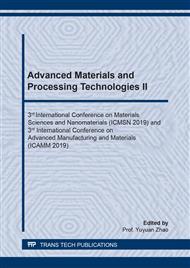p.143
p.151
p.159
p.165
p.175
p.181
p.189
p.195
p.201
Geopolymer Preparation from Bamboo Ash Containing Kaolin as Ash Fusion Control Agent
Abstract:
Bamboo is a prospective biomass fuel due to its high heating value and growth rate. The addition of kaolin is necessary in the thermal conversion of biomass to increase its ash fusion temperature (AFT), thus reducing fouling and corrosion of the combustion system. This study evaluates the feasibility of utilizing bamboo-kaolin co-processing residue for geopolymer synthesis. Thermochemical calculations suggest that bamboo culm ash liquidus increases by 15% by adding kaolin during combustion at a biomass to kaolin mass ratio of 95:5%. A 23 full factorial experiment measures the effect of activator Na2SiO3:KOH ratio, KOH concentration, and heat-curing period at 60 °C on the early strength of geopolymer mortars. Co-processing residue of bamboo-kaolin at a mass ratio of 95:5% produces geopolymer mortars with compressive strengths in the 10.7-40.3 MPa range. ANOVA treatment of the data indicate strong positive effect of KOH concentration. Crystalline phase characterizations indicate that the co-processing is able to convert kaolin to the amorphous, more reactive metakaolin. A shift in the IR absorption band from 1034 to 1008 cm-1 is attributed to the conversion of Si-O-Si bonds of the co-processing residue into Si-O-Al and Si-O-K bonds of the geopolymer gel phase. These results suggest the feasibility of geopolymerization as a waste valorization pathway to ensure the sustainability of the biomass-based energy production.
Info:
Periodical:
Pages:
189-194
Citation:
Online since:
March 2020
Keywords:
Price:
Сopyright:
© 2020 Trans Tech Publications Ltd. All Rights Reserved
Share:
Citation:


